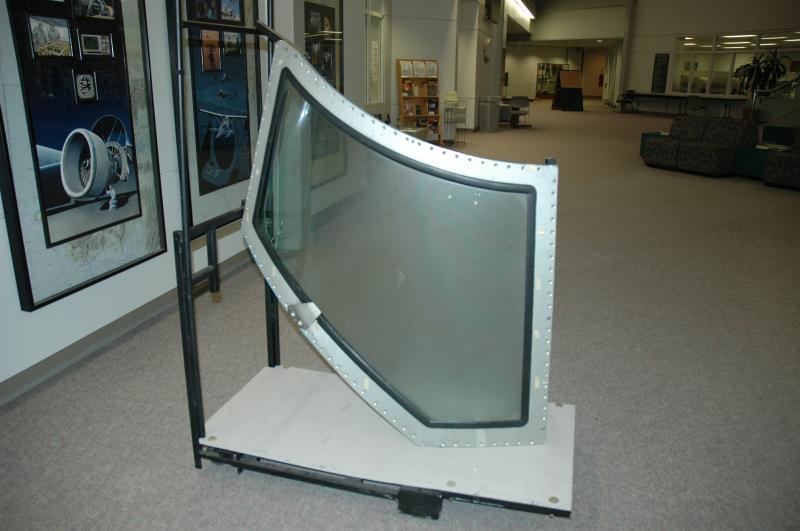
Abraded windscreen from the Boeing 747 damaged in the December 15, 1989 eruption of Redoubt Volcano. This view is from 'outside' the plane looking into the cockpit. You can see the frosted right side of the glass that almost completely obscures the background. On the left, the clearer, less-abraded side received only glancing blows from ash particles as the plane flew through the Redoubt cloud. Imagine trying to land your 747 looking through that frosted glass! This instructive piece of aviation history is housed at the UAA Aviation Technology Division in Anchorage.
Volcano(es): Redoubt
Photographer: Neal, Christina
URL: avo.alaska.edu/image/view/16136
Credit: Image courtesy of AVO/USGS.
Use Restriction: Please cite the photographer and the Alaska Volcano Observatory / U.S. Geological Survey when using this image.
Full Resolution.
Redoubt 1989/12
From Miller and others (1998): "The most recent eruption at Redoubt began with a major phreatomagmatic, vent-clearing explosion at 9:47 am on December 14, 1989 (Brantley, 1990; EOS, 1990; Miller and Chouet, 1994) after less than 24 hours of intense precursory seismicity. Three more ash-rich explosions occurred the following day, December 15, with the last blast generating a pyroclastic flow down the Drift Glacier. The resulting debris flow contained entrained ice blocks as large as 10 m across and crested about 8 m above the river channel near the Drift River Oil Terminal, 35 km downstream (Waitt and others, 1994). A Boeing 747 enroute from Amsterdam that flew into the ash cloud several hours after the eruption experienced complete engine failure and narrowly avoided tragedy when the crew successfully restarted the engines and safely landed in Anchorage (Casadevall, 1994).
"These initial explosive events were just the first of 23 major explosive events between December 1989 and April 1990. Following the mid-December explosive phases, the crater vent emitted only minor ash and steam for the next 5-7 days. From December 22 to January 2, 1990, however, a large, over-steepened lava dome grew over the vent. At 5:48 pm on January 2, the first of two powerful explosions destroyed most of the dome and sent ash plumes to over 12 km. Massive block and ash avalanches down the Drift Glacier generated the largest debris flow of the eruption, completely covering the 2-km-wide valley floor and spilling into Cook Inlet. Flood waters entered the oil terminal, as much as 75 cm deep in some buildings, and caused a temporary halt in operations.
"Three eruptions occurred in the next two weeks during which time the vent remained open. The January 8 event occurred with no precursory warnings and the resulting ashfall on the Kenai Peninsula disrupted commerce and transportation. Open-vent eruptions on January 11 and 16 resulted in minor debris flows down the Drift River.
"After the January 16 eruption, another period of dome growth ensued through mid-February. This dome was smaller than the earlier dome but larger than succeeding domes (Miller, 1994). Early on February 15, the dome was destroyed in an explosive eruption that again sent a large debris flow down the Drift River and blanketed the lower Kenai Peninsula with ash. A pyroclastic flow and surge traveled down the canyon, across the piedmont lobe of Drift Glacier, and swept up the opposite valley wall 700 m topping the ridge (Gardner and others, 1994). Flow down the Drift River was largely diverted into a side drainage that carried flood waters close to oil storage tanks at the downstream oil terminal prompting reinforcement of the containment dikes surrounding the tank farm. A new dome began growing immediately following the eruption.
"On February 21, the new, but considerably smaller, dome was destroyed, marking the beginning of a new trend in eruptive behavior. Characteristically, small domes were emplaced and subsequently destroyed explosively or by gravitational collapse, resulting in debris avalanches down the now ice-free canyon leading down to the Drift River valley, and flooding down the Drift River. Ten such eruptions followed from February 24 to April 21 at 4 to 8 day intervals.
"Following the April 21 eruption, growth of the present lava dome began and continued through early June. During the next several months, seismic activity declined dramatically and only steam emissions and minor rock falls from the dome were recorded as the eruption came to an end.
"The 1989-90 eruption of Redoubt seriously affected the populace, commerce, and oil production throughout the Cook Inlet region and air traffic as far away as Texas. Total estimated economic costs are $160 million (Tuck and others, 1992), making this eruption of Redoubt the second most costly in U.S. history."
From Miller and Chouet (1994): "The eruption produced about 20 significant tephra deposits between December 14 and April 26 (Scott and McGimsey, 1994 - this volume) with a total tephra volume of about 20 to 40 x10^6 cubic m (DRE). Tephra plumes rose off the pyroclastic flows to altitudes in excess of 10 km (Woods and Kienle, 1994 - this volume) and were carried mainly northward and eastward by prevailing winds.
Miller and Chouet (1994) also summarize "The volumes of individual domes ranged from 1 to 30x10^6 cubic m and magma supply rates ranged from 1.8 to 2.5 x10^6 cubic m per day. Total dome volume is estimated at about 90x10^6 cubic m (Miller, 1994 - this volume [Journal of Volcanology and Geothermal Research, 1994, v. 62]).
Miller (1994) estimates total bulk volume of the eruption as 0.1 - 0.2 cubic km.